Chapter 18.06
SIGN REGULATIONS
Sections:
18.06.050 Sign permit applications.
18.06.070 Installation requirements and maintenance.
18.06.090 Permanent signage design guidelines.
18.06.100 Single-tenant permanent signage.
18.06.110 Multi-tenant permanent signage.
18.06.120 Other permanent signage.
18.06.140 Nonconforming signs.
18.06.160 Removal and disposal of illegal signs on public property or within a public right-of-way.
18.06.170 Voluntary compliance incentive.
18.06.010 Intent.
The intent of this chapter is to provide minimum standards to safeguard life, health, property and public welfare by regulating and controlling the number, size, design, quality of materials, construction, location, electrification and maintenance of all signs and sign structures; to preserve and improve the appearance of the town as a place in which to live and as an attraction to nonresidents who come to visit or trade; to encourage sound signing practices as an aid to business and for public information, but to prevent excessive and confusing signing displays. (Ord. 2007-19 § 2, 2007).
18.06.020 Scope.
A. All signs shall comply with this chapter unless listed in EMC 18.06.030, Exempt signage.
B. All signs shall require a sign permit prior to being erected, structurally altered, or relocated unless the permitting requirements are specifically waived in this chapter.
C. A sign permit shall not be required for nonstructural and nonelectrical maintenance.
D. Any sign not expressly authorized by or listed as exempt within this chapter is prohibited within the town of Eatonville.
E. All signs shall comply with all applicable provisions of the Eatonville Municipal Code and with state and federal law.
F. Signs to be located along SR 161 may require a WSDOT permit. Such a permit, if required, shall be obtained prior to erecting a sign within the town of Eatonville. (Ord. 2007-19 § 2, 2007).
18.06.030 Exempt signage.
The following signs shall not require a sign permit. The area and number of exempt signs shall not be included in total number or area of signs permitted for any site or use. This shall not relieve the owner of the sign from the responsibility for its erection, maintenance, or removal and its compliance with the provisions of this chapter or any other ordinance.
A. Official flags of the United States, the state of Washington, and other states of the nations, counties, municipalities, official flags of foreign nations and nationally or internationally recognized organizations; however, flagpoles shall not exceed 50 feet in height.
B. Traffic or other municipal, county, or state signs, signs required by law or emergency, railroad crossing signs, legal notices, and any temporary or non-advertising signs as authorized under policies approved by the town council.
C. Memorial signs or tablets, names of buildings, stained glass windows and dates of erection when cut into the surface or the facade of the building or when projecting not more than two inches.
D. Signs of public utility companies indicating danger or which serve as an aid to public safety or which show the location of underground facilities or of public telephones.
E. Flush-mounted wall signs, used to identify the name and address of the occupant for each dwelling, provided the sign does not exceed two square feet of sign area.
F. Single-family decorative signs indicating family name, welcome, home sweet home, or other similar character signs are exempt; provided, that the sign does not in any way relate to a business or organization.
G. Signs located in the interior of any building or within an enclosed lobby or court of any building or group of buildings, which signs are designed and located to be viewed exclusively by patrons of such use or uses.
H. Reasonable seasonal decorations within a publicly recognized holiday season.
I. Historic or commemorative site markers or plaques.
J. Vehicle signs meeting the following conditions:
1. The primary purpose of such vehicle or trailer is not the display of signs.
2. The signs are magnetic, decals or painted upon an integral part of the vehicle or equipment as originally designed, and do not break the silhouette of the vehicle.
3. The vehicle or trailer is in operating condition, currently registered and licensed to operate on public streets when applicable, and actively used or available for use in the daily function of the business to which such signs relate.
K. Sculptures, fountains, mosaics, and murals which do not incorporate advertising or identification. Any section of art containing advertising or identification shall count against the total number and area of signage.
L. Incidental signs.
M. Banners located at athletic facilities; provided, that such signs are directed inward towards the playing surface(s) and that the banner is in good repair.
N. Barbershop poles of a reasonable size as determined by the planning director.
O. Menu boards. (Ord. 2007-19 § 2, 2007).
18.06.040 Prohibited signage.
The following signs are prohibited within the town of Eatonville.
A. Roof signs except as permitted in EMC 18.06.100(B)(10).
B. Animated signs.
C. Flashing signs (excludes chasing or blinking low wattage lights outlining a marquee).
D. Signs which purport to be, or are, an imitation of, or resemble an official traffic sign or signal, or which bears the words “stop,” “caution,” “danger,” “warning,” or similar words.
E. Signs which, by reason of size, location, movement, content, coloring or manner of illumination may be confused with or construed as a traffic control sign, signal or device, or the light of an emergency or radio equipment vehicle, or which obstruct the visibility of traffic or street sign or signal device.
F. Signs which are located upon or projecting over public streets, sidewalks, or rights-of-way except when specifically authorized in this title.
G. Signs attached to utility poles and street signs.
H. Signs placed on public property except when specifically authorized in this chapter.
I. Off-premises signs except as provided for in EMC 18.06.120(I).
J. Feather signs except as provided in EMC 18.06.080(M).
K. Billboard signs. (Ord. 2014-06 § 1, 2014; Ord. 2007-19 § 2, 2007).
18.06.050 Sign permit applications.
Applications for permits shall contain the name and address of the owner and user of the sign, the name and address of the owner of the property on which the sign is to be located, the location of the sign structure, drawings or photographs showing the design and dimensions of the sign and details of its proposed placement and such other pertinent information as the town planner may require to ensure compliance with this chapter. Permit applications shall be available for inspection by the public upon request. Upon completion of a permit application, the application shall be acted on within three weeks unless there is a requirement for further time under SEPA. (Ord. 2007-19 § 2, 2007).
18.06.060 Sign permit fees.
Sign permit fees shall be set by the town council by resolution. (Ord. 2007-19 § 2, 2007).
18.06.070 Installation requirements and maintenance.
A. Structural Requirements. The town’s adopted building code shall govern the structure and erection of signs or flagpoles within the town. Compliance with the building code shall be a prerequisite to issuance of a sign permit under this chapter.
B. Electrical Requirements. The National Electrical Code shall govern electrical requirements for signs within the town. Compliance with the National Electrical Code shall be required by every sign utilizing electrical energy as a prerequisite to issuance of a sign permit under this chapter.
C. Maintenance. All signs, including signs heretofore installed, shall be constantly in a state of security, safety, appearance and repair. If any sign is found not to be so maintained or is insecurely fastened or otherwise dangerous, it shall be the duty of the owner and/or occupant for the premises on which the sign is fastened to repair or remove the sign within 10 days of receiving notice from the town planner. The appearance of signs shall be maintained including:
1. Repainting to repair weathered, flaking, or chipped paint; and
2. Replacement of any damaged, faded, or discolored materials; and
3. Maintenance of all lighting.
D. Landscaping for Freestanding Signs. All freestanding signs shall include as part of their design landscaping about their base so as to prevent vehicles from hitting the sign and to improve the overall appearance of the installation. The premises surrounding the base of a sign shall be kept free and clear of rubbish and the landscaping shall be maintained in a tidy manner.
E. Inspection. All sign users shall permit the periodic inspection of their signs by the town upon town request.
F. Location. All freestanding signs, permanent or temporary, at a height greater than two and one-half feet and less than eight and one-half feet shall not obstruct the required sight triangle. (Ord. 2007-19 § 2, 2007).
18.06.080 Temporary signs.
Temporary signs are permitted subject to the following conditions:
A. Construction Signs.
1. Construction signs which are to be displayed for less than 30 days shall be known as “temporary construction signs.” Construction signs to be displayed for more than 30 days shall be known as “semi-permanent construction signs.”
a. Temporary Construction Signs.
i. Temporary construction signs shall not require a permit.
ii. Temporary construction signs shall not exceed 12 square feet in area and six feet in height.
iii. There is a maximum of two temporary construction signs per lot.
iv. Temporary construction signs may be displayed only after a building permit for the site is obtained and during the period of construction on the construction site.
b. Semi-Permanent Construction Signs.
i. Semi-permanent construction signs shall require a sign permit.
ii. Such signs may be displayed only after a building permit for the site is obtained and during the period of construction on the construction site.
iii. Only one semi-permanent construction sign is permitted per street frontage.
iv. In all zones other than single-family residential zones, no semi-permanent construction sign shall exceed 32 square feet in sign area (printed copy on one side only) or 10 feet in height, nor be located closer than 10 feet from the property line or closer than 30 feet from the property line of the abutting owner.
v. In single-family residential zones, no semi-permanent construction sign shall exceed 32 square feet in sign area (printed copy on one side only) or 10 feet in height, nor be located closer than five feet from the property line nor be located closer than 10 feet from the property line of the abutting owner.
B. Grand Opening Displays. No sign permit is required. Such temporary signs, posters, banners, strings of lights, clusters of flags, balloons or other air- or gas-filled figures, and searchlights are permitted for a period of seven days only to announce the opening of a completely new enterprise or the opening of an enterprise under new management. All such materials shall be removed immediately upon the expiration of seven days. Such displays are permitted only in commercial zones where the enterprise so advertised is allowed under zoning regulations. Searchlights may be permitted by any business or enterprise, provided the beam of light does not flash against any building or does not sweep an arc less than 45 percent from the vertical.
C. Special Event Signs. No sign permit is required. Such temporary signs may be placed upon private property only and shall not be larger than four square feet. Said signs shall not be posted or attached to telephone poles, power poles, town parks or other public utility facilities. Such signs may be displayed 30 days prior to an event and must be removed within seven days after the event conclusion. The event committee for which the sign is displayed shall be responsible for its removal and subject to the penalties as provided in this chapter. Searchlights may be permitted by any business or enterprise provided the beam of light does not flash against any building or does not sweep an arc less than 45 percent from vertical.
D. Real Estate Signs. No permit is required. All exterior real estate signs must be wood, plastic, or other durable materials. Said signs shall not be posted or attached to telephone poles, power poles, town parks or other public utility facilities. The permitted signs, with applicable limits are as follows:
1. Residential “For Sale” and “Sold” Signs. Such signs shall be limited to one sign per street frontage not to exceed six square feet in sign area, placed wholly on the property for sale, and not to exceed a height of six feet.
2. Residential Directional “Open House” Signs. Such signs shall be limited to one sign per street frontage on the premises for sale and three off-premises signs. However, if a realtor has more than one house open for inspection in a single development or subdivision, he/she is limited to four off-premises “open house” signs in the entire development or subdivision. Such signs are permitted only during daylight hours and when the realtor or seller or an agent is in attendance at the property for sale. No such sign shall exceed five square feet in sign area.
3. Undeveloped Commercial and Industrial Property “For Sale or Rent” Signs. One sign per street frontage advertising undeveloped commercial or industrial property for sale or rent. The sign shall not exceed 32 square feet in sign area and seven feet in height.
4. Developed Commercial and Industrial Property “For Sale or Rent” Signs. One sign per street frontage advertising a commercial or industrial building for rent or sale is permitted while the building is actually for rent or sale. If one face of the building is less than 10 feet from the property line, the sign shall be placed on the building or in the window. The sign shall not exceed seven feet in height and, if freestanding, shall be more than 15 feet from any abutting property line or a public right-of-way line. Said sign shall not exceed 32 square feet in sign area.
5. Undeveloped Residential Property “For Sale” Signs. One sign per street frontage advertising undeveloped residential property for sale is permitted not exceeding 32 square feet in sign area. Said sign must be placed more than 30 feet from the abutting owner’s property line and may not exceed a height of seven feet.
6. Subdivisions approved after the effective date of the ordinance codified in this section are permitted one cluster of flagpoles (not to exceed five flagpoles) in front of sales offices to advertise the new development.
E. Political Signs.
1. No sign permit is required.
2. Political signs shall be removed within 10 days of an election.
3. Political signs shall not exceed 10 square feet in area.
4. Political signs shall not exceed six feet in height.
5. Political signs are prohibited from placement on public property or in the public right-of-way except for election signs when located in parking strips and other landscaped areas where such a strip may be fairly attributed to an adjacent property owner and when that adjacent property owner has personally placed or given permission to place the political sign.
6. Political signs shall be unlit.
7. Political signs shall not be erected or affixed on or to any public property or utility poles and in no event may political signs be erected or affixed by any person on or to any property without the consent of the owner or occupant of such property.
F. Civic Activity Signs. Civic activity signs shall require a permit. Any sign that advertises a civic event open to the public and sponsored by a political subdivision of the state, educational institution, religious institution, civic or fraternal organization, or not-for-profit organization is permitted as follows:
1. Any person or organization desiring to erect a temporary civic activity sign shall make application to the planning director or his/her designee in writing at least 30 days prior to erecting the sign. The planning director may make exception to this timing requirement at his or her discretion.
2. The planning director or his/her designee may grant permission for the installation of an off-site civic activity sign on public property for a period not to exceed 30 days if, in his/her opinion, the proposed display or sign will not adversely affect the neighborhood or create a nuisance to the surrounding area.
3. Civic activity signs shall not exceed 32 square feet and shall not be higher than six feet in height.
G. Community Banners or Cloth Signs. Community banners shall require permits. Such signs may be permitted and extended across the public street by permission of the town planner or approved representative. Such signs may only be placed at town-designated locations and erected by town personnel. Signs may be hung three weeks before an event and must be taken down no later than two days after the event is concluded.
H. Banners. Banners shall require a sign permit. Such signs may be permitted on private property. Banners may be used to advertise a sale, other special events, or for businesses waiting for a permanent sign. Businesses are only allowed one banner per wall with a maximum of two banners per business at any one time. All banners must comply with the following:
1. Maintenance Standards. All banners must be legible, made of durable materials and must be well maintained.
2. Time Limitation. Banners are limited to two 30-day placements per calendar year.
3. Location on Property. Banners must be located completely on a wall, and tacked down on four corners. Banner size shall be regulated to a maximum of 10 percent of the architectural elevation per wall.
I. A-Board Signs (Sandwich Boards).
1. A-board signs shall require a permit.
2. A-board sign faces shall be a maximum of 48 inches in height by 32 inches in width.
3. Any application for a permit to locate an A-board sign in a public right-of-way shall include in the application a certificate of liability insurance naming the town of Eatonville as additionally insured. The certificate of liability shall be in the form of general commercial liability insurance in a minimum amount of $1,000,000 per occurrence.
4. A-frame signs may be permitted in a multi-tenant complex if allowed as part of an approved sign program.
5. There shall be a maximum of one A-board per street frontage per business.
6. A-board signs shall allow for a clearance of paved walkways of not less than 42 inches.
7. A-board signs shall be allowed for commercial uses only.
8. A-board signs shall be constructed of metal, wood, chalkboard, or white board and shall be designed to resist wind loads.
9. A-board signs shall be removed when the establishment is not open for business.
10. A-board signs shall be kept in a legible, intact, and well-maintained manner.
11. A-board signs shall not be lit.
12. A-board signs shall be located on or immediately adjacent to the business or building to which the sign is associated.
J. Garage Sale Signs (Yard Sale, Moving Sale, Patio Sale). No sign permit is required. Such signs shall be limited to one sign on the premises and three off-premises signs. No such sign shall exceed four square feet in sign area. The off-site signs shall be attached to a two- to four-foot wooden stake and may be stuck into the ground within a public right-of-way or on private property with that property owner’s permission, but shall not obstruct pedestrian paths. Off-site signs shall include the address where the sale is to be located. The sign or signs may be displayed only during the sale and must be removed the day the sale ends. Signs may not be attached to light poles, power poles, street signs, and may not be placed in any parks including welcome point. The person or persons for whom the sign or signs are displayed shall be responsible for its removal and subject to the penalties as provided by this title.
K. Seasonal Signs. No sign permit is required. Vendors who receive a temporary business license for seasonal or temporary sales activities (e.g., Christmas trees or fireworks) are permitted one sign not to exceed 20 square feet in sign area. This sign shall be mounted to the booth or trailer used for temporary sales.
L. Temporary Window Signs. Temporary window signs shall not cover more than 25 percent of any window and shall be immediately removed or replaced in the event that such a sign deteriorates from its original condition. Temporary window signs may be displayed for no longer than 30 days.
M. Feather Signs. Feather signs shall require a sign permit within the downtown and general commercial zoning districts (C-1 and C-2). In addition to all other permitted signs, a maximum of two on-site feather signs may be permitted for each business. Such signs may contain language, design(s) and/or pictures for advertisement, greeting or similar commercial messaging purposes. To preserve the aesthetic value of the town, feather signs shall be prepared in appearance or in fact by design professionals (e.g., graphic designers, professional sign shops). Feather signs shall be:
1. A maximum of 14 feet in height.
2. No more than 37.5 inches in width.
3. Located only on the business’s private property.
4. A minimum of one foot from driveways and sidewalks (or curb if no sidewalk is present).
5. A minimum of five feet from the side yard lot line.
6. Placed no closer than 10 feet from all signs.
7. Designed and located in a way that does not create a safety hazard (including but not limited to vehicular and/or pedestrian traffic and movement).
8. Kept neat and orderly around the base.
9. Securely anchored in a temporary fashion.
10. Subject to inspection for compliance with all applicable regulations.
11. Businesses with an existing illegal sign shall be prohibited from using feather signs.
12. Feather signs must be replaced once they becomes faded, ripped or tattered as determined by the mayor or his/her designee. (Ord. 2014-06 § 2, 2014; Ord. 2007-19 § 2, 2007).
18.06.090 Permanent signage design guidelines.
A. Administration. The following design guidelines shall be administered by the planning director in addition to the sign regulations contained in this chapter. All signs and sign programs approved shall comply generally with the guidelines in subsection B of this section. Once a sign program is approved, individual signs under that program shall not be reviewed under the design guidelines. If a sign permit is denied because the planning director finds that the sign proposal does not comply with the design guidelines and if the applicant disagrees with the director’s finding, they may appeal the decision to the design review board. Until such a board is created, the planning commission shall hear appeals to the design review board. The use of the word “shall” in the design guidelines is obligatory. The use of the word “should” in the design guidelines means that the guideline is a requirement if it is applicable to the particular sign proposal. The planning director or the design review board may use their discretion in review of sign proposals under the design guidelines and shall have the authority to determine in their professional opinion which guidelines apply on a case-by-case basis. Design review board decisions shall be final.
B. Sign Guidelines.
1. Intent.
a. Signs should be used primarily for the purpose of identification or conveying recognition of a particular business or development.
b. Signs should be consistent with building design and surrounding structures, and be appropriate to the type of activity to which they pertain. Design elements such as size, material, lighting, color, lettering style and the number and arrangement of signs should present a professional appearance and a quality of permanence.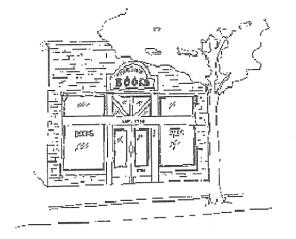
Figure 1: Sign criteria (B)(1)(a) through (g) of this section.
c. The shape of the sign should strive for simplicity with all elements constituting an integrated design with the building and the landscaping.
d. A sign should be legible.
e. A sign should not overshadow its building or surroundings.
f. The scale of a sign should be in proportion with the building or site to which it pertains.
g. For historic landmarks, a sign should be consistent with the historic character and should not obscure significant features.
DON’T DO THIS: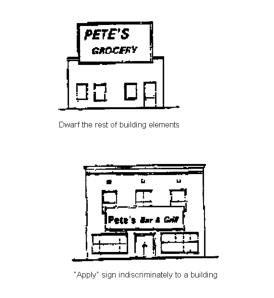
DO THIS: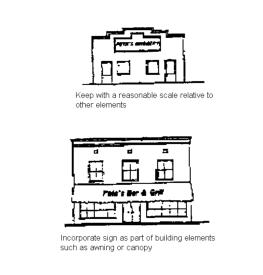
Figure 2: Sign design criteria of this section.
2. Design Criteria.
a. Sign Message.
i. Signs should be used primarily for the purpose of identification, conveying recognition of a particular enterprise, group of enterprises, or franchise. The sign message shall be the name identification of the business. Project and service information may only be integrated into the primary signs as smaller, secondary copy.
ii. The sign message, if oriented towards automobile traffic, should reflect the speed of traffic and the distance at which the sign is seen.
iii. Use of easily recognized symbols, such as logos, is encouraged.
iv. Signs should provide for good aesthetic presentation of the sign message through careful consideration of color combinations, illumination, sign placement, letter height, proportion and spacing, and by avoiding use of small and/or excessive lettering.
v. The shape of a sign should strive for simplicity with all elements constituting an integrated design.
vi. The use of third party signs is discouraged. If a third party sign is necessary, the size of that sign shall be included in overall allowed square footage for signs permitted under this chapter.
vii. The advertising content of signs should be simplified so that it does not detract from the identification purpose and the legibility of signs.
b. Color.
i. Colors should be used which are complementary and restrained. Bright and brilliant colors should be avoided except for use as accent color. No specific color or combination of colors is prohibited.
ii. Sign colors should be visible without being garish, and consideration should be given to the contrast between sign letters and their background.
iii. Signs should be oriented to the roadway and sidewalks and not toward adjacent residential, recreational, or open space uses.
iv. Franchises are subject to the same signage standards as other commercial uses, and are strongly encouraged to use the minimum amount of signage and building features to convey corporate identity.
c. Illumination.
i. Illumination from or upon any sign shall be shaded, shielded, directed, or reduced so as to avoid undue brightness, glare or reflection of light on private property in the surrounding area, and so as to avoid distracting pedestrians and motorists. “Undue brightness” is illumination in excess of that which is reasonably necessary to make the sign reasonably visible to the average person on the adjacent street. Illumination, if used, shall be what is known as white or yellow and shall not be blinking, fluctuating, or moving. Light rays shall shine upon only the sign or upon the property on which the sign is located and shall not spill over the property lines in any direction, except by indirect reflection.
ii. Indirect lighting is encouraged.
d. Wall Signs.
i. The size and location of wall signs shall be reviewed in terms of their relationship to the building entry, height of sign fascia, or size of wall where the sign is to be installed and the relationship to other signs on a building, as well as visibility from the street, sidewalk or parking lot.
ii. On multi-tenant buildings wall signs should be evaluated for compatibility as part of a sign program with the building fascia and neighboring signs in terms of size, color, lighting materials, sign style, and quality.
iii. The depth of wall signs on multi-tenant buildings should be consistent.
e. Freestanding Signs.
i. Freestanding signs shall be of a style, material, and design compatible with the associated building.
ii. Berming shall not be used to exceed the maximum allowable height of signs.
iii. The base or support elements of freestanding signs should be integrated with the surrounding environment. Landscaping may be required to buffer such signs.
iv. Freestanding signs should be sited so that they integrate with the location of street trees and other site landscaping, and to avoid obscuring the view of adjacent freestanding signs. (Ord. 2007-19 § 2, 2007).
18.06.100 Single-tenant permanent signage.
A. Number.
1. Each single-tenant business may erect signs not to exceed the maximum number allowed for each type of sign as follows:
a. Freestanding and Projecting Signs. Each single-tenant business may erect one freestanding or projecting sign per street frontage.
b. Wall Signs. Single-tenant businesses may erect one wall sign per building elevation (maximum four).
c. Window Signs. Each business may erect one permanent window sign per window.
d. Marquee Signs. A business may erect a marquee in lieu of a projecting sign and wall sign on that building face.
e. Awning Signs. One awning sign per building face is permitted; however, the number of awnings is not limited.
f. Roof Signs. One roof sign per business may be approved if it meets the requirements of this chapter.
B. Sign Types and Requirements.
1. Freestanding Pole Signs.
a. One pole sign up to 20 feet in height and up to 50 square feet in area may be permitted; provided, that the planning director determines that the sign proposal meets the following criteria:
i. The building to which the pole sign is to be associated existed prior to the adoption of the ordinance codified in this chapter. (New buildings should be designed with other types of signage in mind.)
ii. There are preexisting structural or architectural features which prohibit the effective use of wall, projecting, marquee, and awning signs, and the only possible location for a ground sign would obstruct a required sight triangle or would unavoidably result in the loss of more than one parking stall.
b. A pole sign may not be approved for a business in conjunction with a roof sign on the same street frontage.
c. Maximum sign area shall be based on street frontage as follows:
|
Parcel Frontage |
Maximum Area per face |
Maximum Height |
|---|---|---|
|
< 50 feet |
24 square feet |
15 feet |
|
50 – 99 feet |
36 square feet |
20 feet |
|
100 feet and over |
50 square feet |
20 feet |
2. Freestanding Ground Signs.
a. Maximum height depends on frontage length:
i. < 50 frontage feet: six feet maximum height;
ii. 50 – 150 frontage feet: seven feet maximum height;
iii. > 150 frontage feet: eight feet maximum height;
b. Maximum area:
i. < 50 frontage feet: 30 square feet per face;
ii. 50 – 150 frontage feet: 42 square feet per face;
iii. > 150 frontage feet: 56 square feet per face;
c. Maximum Monument Structure Size. The monument sign structure shall not exceed the allowable sign area by greater than 20 percent.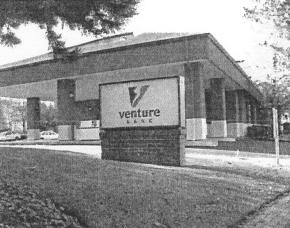
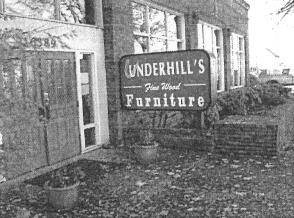
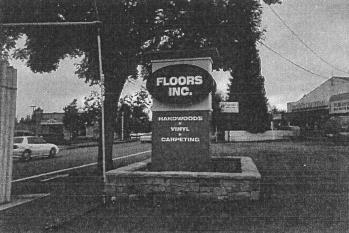
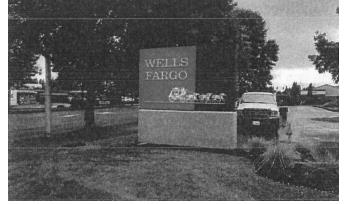
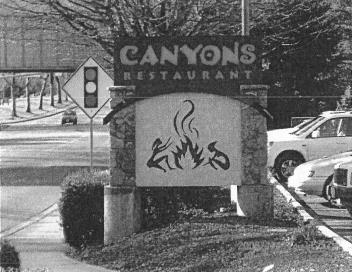
3. Freestanding monument signs are prohibited.
4. Freestanding pylon signs are prohibited.
5. Projecting Signs.
a. Location. Projecting signs shall be attached to a wall which fronts a street.
b. Maximum Height. The mid-point of a projecting sign shall not be any higher than the mid-point of the second story of the building to which it is attached. In any event, a projecting sign shall be no higher than 25 feet in height above the adjacent ground and shall not be higher than the associated building.
c. Maximum Area. Maximum projecting sign area shall be based on the width of the street-facing wall to which the sign is attached:
|
Street-Facing Wall Width |
Maximum Projecting Sign Area |
|---|---|
|
< 20 feet |
16 square feet |
|
20 – 35 feet |
25 square feet |
|
> 35 feet |
36 square feet |
d. Projecting signs shall have a maximum of two sign faces.
e. Projecting signs shall not project more than eight feet from the wall of the building to which the sign is attached and when projecting into a public right-of-way shall not project to within two feet of the curb line.
6. Awnings.
a. Awnings shall not be backlit.
b. The area of signage to be printed on an awning shall not exceed 30 percent of the total area of the exposed face of the awning on which the signage is to be located. The signage area shall be calculated on the smallest rectangle, circle, or spherical figure which will enclose the entire copy area of the sign. Any calculation shall include the area between the letters and lines as well as the area of any devices which are intended to attract attention.
c. Below an awning, one hanging sign up to four square feet in area may be permitted per business per street frontage; provided, that it shall not hang less than eight feet above the sidewalk below.
d. Awnings may project into a public right-of-way but shall not project further than to within two feet of the curb line.
7. Wall Signs. The surface area of any building-mounted sign or canopy-mounted sign shall not exceed the figures derived from the following schedule:
|
Architectural Building Elevation Wall Area |
Maximum Sign Surface Area (For That Wall Area) |
|---|---|
|
Below 100 sq. ft. |
18 sq. ft. |
|
100 – 199 sq. ft. |
18 sq. ft. + 11% of facade area over 100 sq. ft. |
|
200 – 499 sq. ft. |
30 sq. ft. + 6% of facade area over 200 sq. ft. |
|
500 – 999 sq. ft. |
48 sq. ft. + 6% of facade area over 500 sq. ft. |
|
1,000 – 1,499 sq. ft. |
78 sq. ft. + 6% of facade area over 1,000 sq. ft. |
|
1,500 – 2,999 sq. ft. |
108 sq.ft. + 3% of facade area over 1,500 sq. ft. |
|
Over 3,000 sq. ft. |
153 sq. ft. + 3% of facade area to a maximum of 200 sq. ft. |
8. Marquee Signs. Marquees are to be considered a structural part of a building and shall require a building permit. Marquees may project into a public right-of-way but shall not project further than to within two feet of the curb line. Signs which are to be erected on a marquee shall not exceed 30 percent of the background of the face of the marquee to which the sign is affixed.
9. Window Signs. Permanent window signs shall not exceed 30 percent of the total area of the window on which the sign is to be affixed.
10. Roof Signs. Roof signs may be on buildings existing prior to the adoption of the ordinance codified in this chapter in lieu of a wall sign on the building face to which the roof sign is associated; and providing, that the roof sign proposal meets the following criteria:
a. The sign proposal represents a superior design due to the incompatibility of freestanding, projecting, awning, marquee, and wall signs with the architecture of the building or the site.
b. The sign proposal’s primary purpose is not to increase sign visibility from a distance greater than that of which a freestanding, projecting, awning, marquee, or wall sign which conforms to the requirements of this title would be visible.
c. The sign area of the roof sign shall not exceed the square foot area which would be allowed for a wall sign on the face of the building to which the sign is associated.
d. A roof sign shall not be approved for a business in conjunction with a pole sign on the same street frontage. (Ord. 2007-19 § 2, 2007).
18.06.110 Multi-tenant permanent signage.
A. Approved Sign Program Required. When more than one business occupies a lot, building, or complex, all signs for businesses on the lot or within the building or complex shall be based on a uniform sign concept approved by the planning director and which conforms to the requirements of this section. All subsequent tenant/unit signs must conform to the approved sign program in addition to sign review criteria contained in this chapter unless a modification from the sign program is requested by the property owners. The sign program shall establish standards and criteria for all signs in the complex that require permits, and shall address, at a minimum, the following:
1. Proposed sign locations.
2. Materials.
3. Type of illumination.
4. Design of freestanding sign structures.
5. Size.
6. Quantity.
7. Uniform standards for nonbusiness signage, including directional and informational signage.
B. Number.
1. Each multi-tenant building may erect the following types of signs not to exceed the maximum number allowed for each type of sign as follows:
a. Freestanding Signs.
i. Multi-tenant buildings or complexes with less than 300 feet of frontage may have one freestanding sign.
ii. Multi-tenant buildings with 300 feet or more frontage may have two freestanding signs.
iii. Individual businesses are not permitted individual freestanding signs (except for service stations); however, the freestanding sign as permitted for the multi-tenant building or complex may be a ganged sign listing the names of the businesses located in the multi-tenant building or complex.
b. Wall Signs. Each business within a multi-tenant complex may have one wall sign per building elevation (maximum four).
c. Projecting Signs. Projecting signs are permitted on freestanding buildings within a multi-tenant complex.
d. Window Signs. Each business may erect one permanent window sign per window.
e. Marquee Signs. Marquee signs are permitted for theaters within a multi-tenant complex.
f. Awning signs are permitted.
C. Sign Type and Requirements.
1. Freestanding Signs.
a. Ground Signs. Ground signs are permitted as follows:
|
Total ROW Frontage |
Allowable Sign Area |
Allowable Sign Structure Size |
Maximum Height |
|---|---|---|---|
|
< 100 feet |
36 square feet |
54 square feet |
6 feet |
|
100 – 199 feet |
56 square feet |
78 square feet |
7 feet |
|
200 – 299 feet |
66 square feet |
88 square feet |
7 feet |
|
300 feet and over |
72 square feet |
90 square feet |
8 feet |
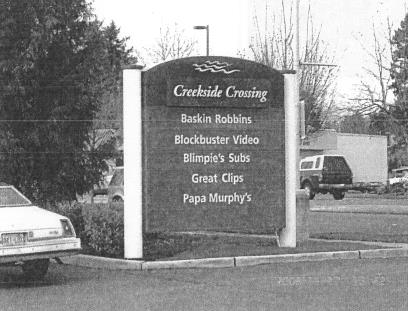
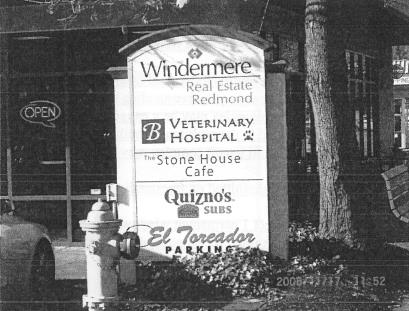
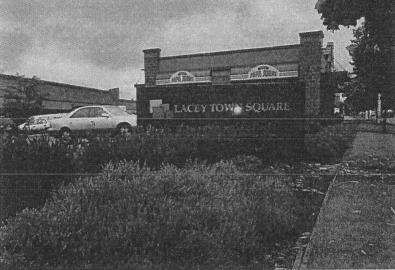
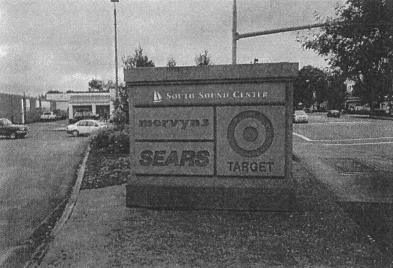
b. Monument and Pylon Signs. Monument and pylon signs are permitted as follows:
|
Total ROW Frontage |
Allowable Sign Area |
Allowable Sign Structure Width |
Allowable Structure Height |
|---|---|---|---|
|
200 – 299 feet |
66 square feet |
7 feet |
18 feet |
|
300 feet and over |
72 square feet |
8 feet |
20 feet |
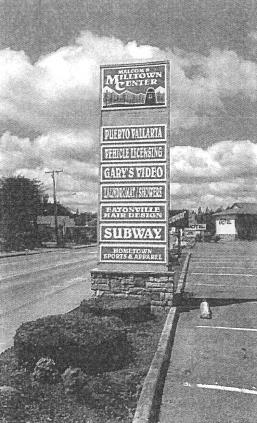
c. Pole signs are prohibited.
d. When more than one freestanding sign is permitted for a multi-tenant complex, the freestanding signs shall be spaced a minimum of 100 feet apart.
2. Wall signs are permitted in accordance with the requirements of EMC 18.06.100(B)(7).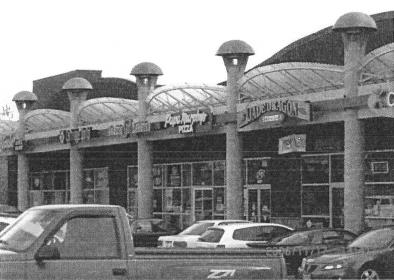
Wall Signs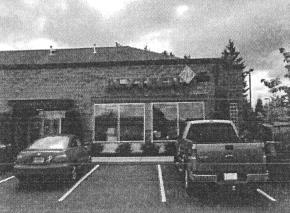
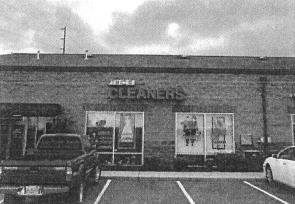
3. Projecting signs are permitted in accordance with the requirements of EMC 18.06.100(B)(5)(b) and (c).
4. Window signs are permitted in accordance with the requirements of EMC 18.06.100(B)(9).
5. Marquee signs are permitted in accordance with the requirements of EMC 18.06.100(B)(8).
6. Awnings are permitted in accordance with the requirements of EMC 18.06.100(B)(6).
7. Roof Signs. Roof signs are not permitted in multi-tenant complexes. (Ord. 2007-19 § 2, 2007).
18.06.120 Other permanent signage.
A. Service Station Signage.
1. Service stations may have an additional four square feet per face per fuel type (maximum of four fuel types) to advertise fuel prices.
2. Service stations may advertise the brand of gasoline on the side of a service station canopy. Sign lettering shall not exceed 20 inches in height.
3. If a service station is located in a multi-tenant complex, the service station may have an additional freestanding sign (in addition to that allowed for the multi-tenant complex) for the purposes of identification and fuel price display.
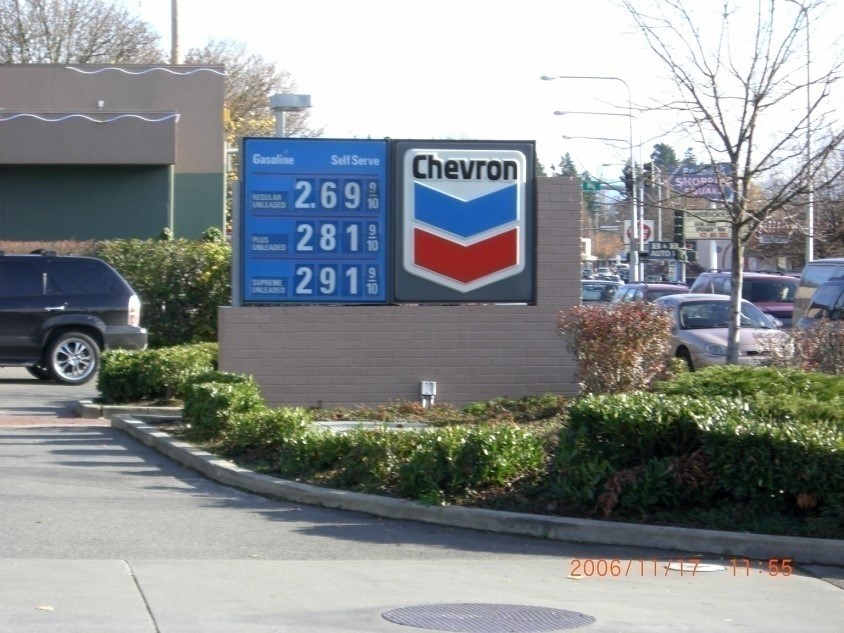
B. Subdivision Signage. Up to one permanent single-faced ground sign may be placed per side of a street or driveway per entrance to a subdivision or PUD for the purposes of identifying the name of the development; provided, that the sign(s) be no taller than seven feet in height and 32 square feet per face in text or graphical area. Signs may be located within a public right-of-way if approved by the planning director. The area around such signs shall be landscaped and provision for the maintenance of the landscaped area shall be a condition of approval. Signs shall be constructed of masonry, stone, metal, or wood and, if lit, shall be lit indirectly.
C. Address Signs. Each residence, building, business, or complex of businesses shall display and maintain on-premises street address number identification. The number or letters shall be visible from the street and be at least six but not greater than 12 inches high and of a color contrasting with the background upon which placed. Street address identification signs shall not require a sign permit.
D. Bulletin Boards.
1. Bulletin boards shall require a sign permit.
2. Bulletin boards shall be incorporated into the design of a freestanding or wall sign.
3. If a bulletin board is to be combined into the design of a freestanding or wall sign, an additional 12 square feet in area per face in addition to that which is allowed for the freestanding or wall sign shall be allowed.
4. The bulletin board shall be limited in height to the maximum height of the sign into which it is being incorporated.
5. Bulletin boards may be single- or double-faced.
6. Changing message center signs may be used as a bulletin board subject to the following requirements:
a. Messages on electronic reader boards shall be fixed for a minimum of five seconds.
b. Flashing messages, scrolling messages, and animation are prohibited.
c. In between each five-second fixed message, the sign may switch to the time and temperature which shall be displayed for a minimum of two seconds.
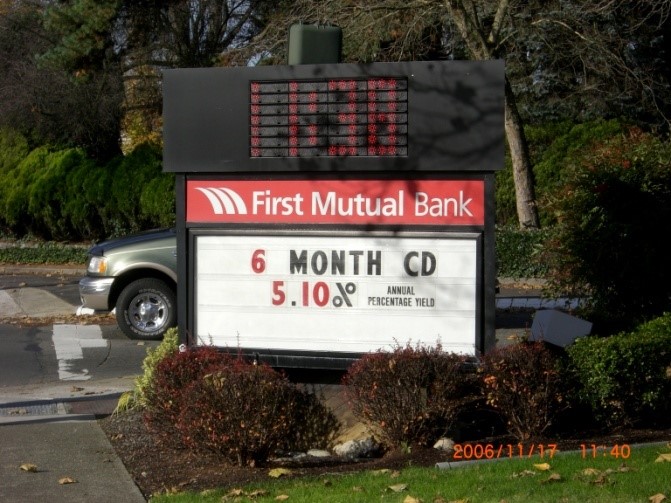
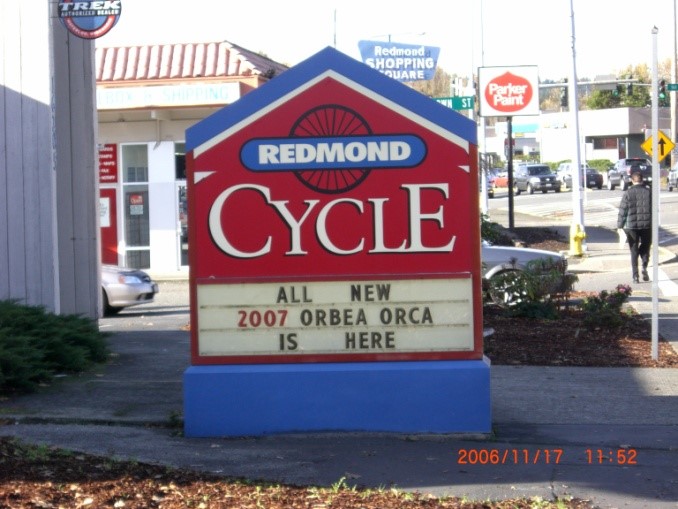
E. Way-Finding Signage. All way-finding signage shall be erected in accordance with a way-finding signage plan to be approved by the planning director. All way-finding signage to be erected within the town shall be of a uniform design concept.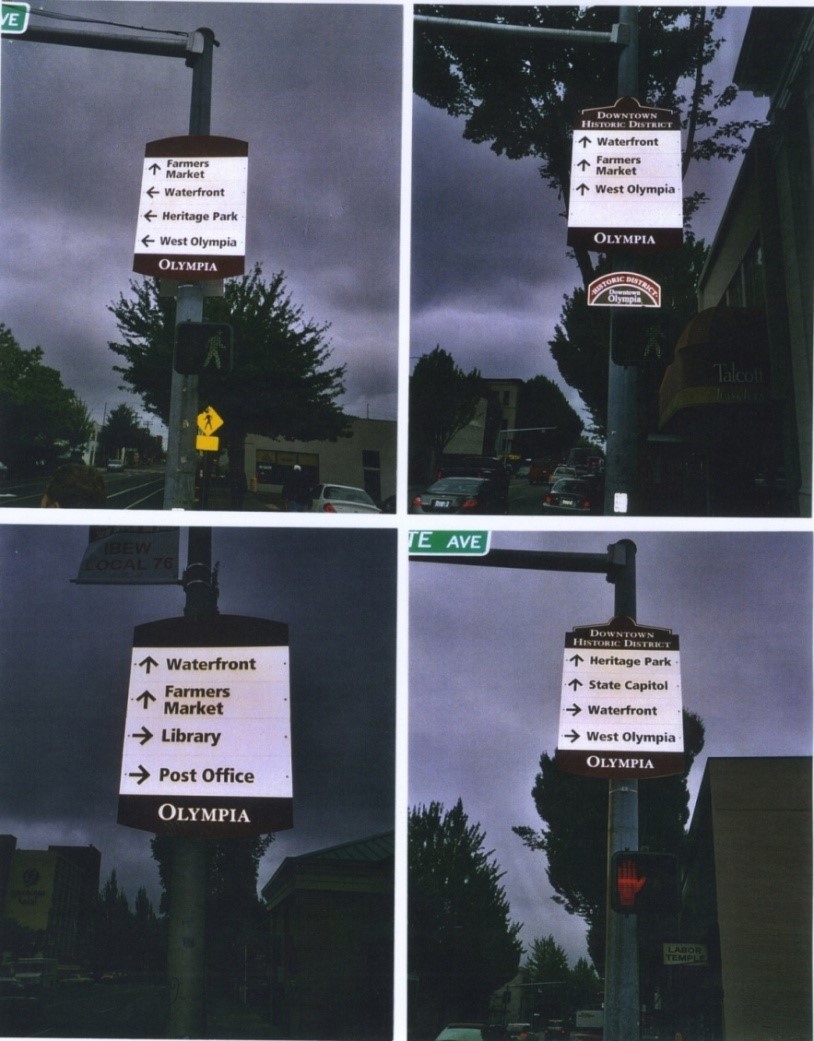
F. Home Occupations. Home occupations located in SF or MF zones are limited to one two-square-foot sign which may be indirectly illuminated.
G. Multifamily Buildings. A multifamily building which is not part of a complex may erect one sign not to exceed 18 square feet in area and five feet in height. Rental information such as name and contact information may be included as a subservient portion of the sign. Signs may be wall-, ground-, or fence-mounted.
H. Multifamily Complexes. Multifamily complexes are permitted two signs per entrance not to exceed 18 square feet in area and five feet in height. Rental information such as name and contact information may be included as a subservient portion of the sign. Signs may be wall-, ground-, or fence-mounted.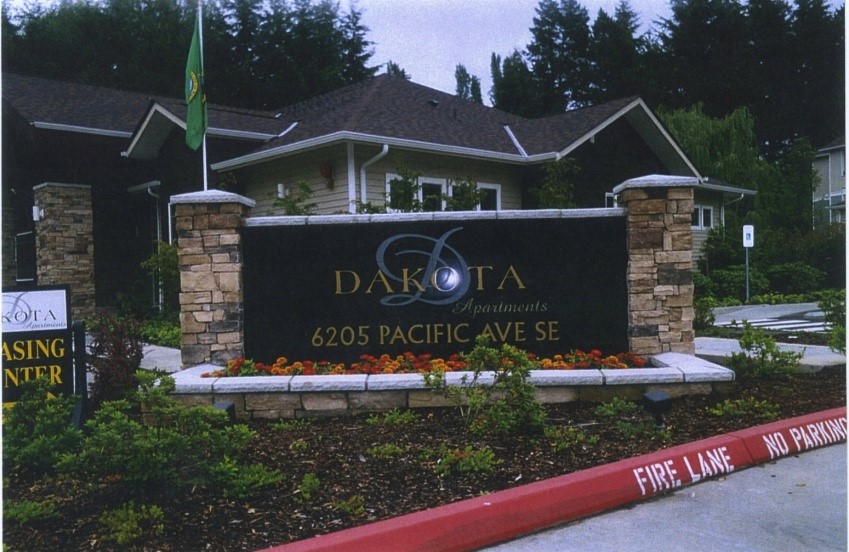
I. Off-Premises Signs.
1. Off-premises signs may be erected by any building owner (or business owner in the event of a single-tenant building) who has a single-tenant building or multiple-tenant complex which is not located on an arterial or collector. Such a sign may be placed on private property (in addition to any other signs on that property) with the permission of that property owner and after obtaining a sign permit. There is a maximum of one sign per business and such a sign shall either be consistent with the town’s way-finding signage plan or shall be of a similar construction to way-finding signage as follows.
a. The sign(s) shall be mounted on a pole not to exceed nine feet in height.
b. The sign(s) shall be of a maximum dimension of 42 inches by 10 inches.
c. The sign(s) may include the name of the business or service and a directional arrow.
Below is an example of way-finding signage and of the type of sign which would be suitable for use as an off-site sign.
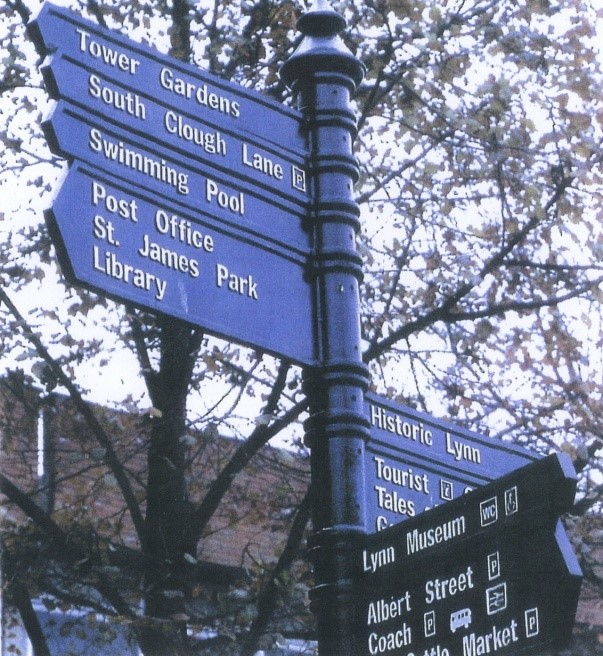
2. A public agency may erect an off-premises sign on town-owned property subject to compliance with the application procedures, sign regulations, design standards, and fees set forth in this chapter. Applications from public agencies to erect off-premises signs on town-owned property shall be reviewed and approved by the town council. The applicant shall have the burden of demonstrating:
a. The sign meets applicable town sign regulations and design standards;
b. The applicant’s property is subject to site constraints and/or unique circumstances are present that warrant the placement of the off-premises sign on the town’s property; and
c. The sign location and design will: (i) be reasonably consistent with any existing or future development or utility plans; (ii) not create vehicular or pedestrian safety hazards; and (iii) not create an unreasonable impediment to the use of the town’s property, or any right-of-way, access or utility easement.
The applicant shall execute a lease in a form satisfactory to the town attorney and approved by the town council. The town council may elect to forward the public agency’s sign application to the planning commission for a recommendation, which shall be returned to council in no more than 60 days.
J. Internal Circulation Signage. Such signs may be used to indicate vehicle entrances, exits, drive-thrus, or other instructions, but may not contain commercial advertising. Internal circulation signage shall not require a permit. Maximum two and one-half feet high, maximum two feet width, maximum six-inch-high lettering size and these signs may also be designed to be on poles.
K. Informational Signs. Such signs shall require a permit and may be used for informational purposes only, and not for advertising copy. Such signs may be a maximum of six square feet in size, must be designed in a uniform manner using a single background color and a single color and typeface for wording and may be designed to be on poles. (Ord. 2014-06 § 3, 2014; Ord. 2007-19 § 2, 2007).
18.06.130 Historic signs.
Historic character signs which do not meet certain requirements of this title may be approved on a case-by-case basis by the design review board. (The planning commission shall act as the design review board until such a board is created.) Such sign proposals may be approved if the design review board determines that such a sign meets the following criteria:
A. The sign proposal would enhance the historic character of the town.
B. The sign’s character is consistent with the architecture and era of the structure to which it is to be associated.
C. The sign would not have a negative impact on the use of surrounding properties (i.e., the sign would not block views, produce excessive glare, etc.).
D. The sign proposal is generally consistent with the intent of the permanent signage design guidelines. (Ord. 2007-19 § 2, 2007).
18.06.140 Nonconforming signs.
A. Any sign legally existing at the time of passage of the ordinance codified in this chapter that does not conform to this chapter in use, height, size, or location shall be considered a legal nonconforming use or structure and shall be permitted to continue in such status; provided, that the degree of nonconformity is not increased and until one of the following occurs:
1. Structural repairs are proposed or required which will exceed 50 percent of the total cost of replacement for the sign; or
2. The building or property to which the sign is associated is improved in an amount that exceeds 25 percent of the current county-assessed improvement valuation; or
3. The sign is an abandoned sign.
B. Additionally, nonconforming signs shall be maintained and improved to the highest degree possible including:
1. Repainting to repair weathered, flaking, or chipped paint; and
2. Replacement of any damaged, faded, or discolored materials; and
3. Maintenance of all lighting; and
4. The planting and maintenance of a landscaping area surrounding the base of a freestanding sign. This landscaping area shall be kept free of litter and debris at all times.
5. The failure of an owner to comply with these requirements shall result in a notice of violation and a timeline for which to either comply or remove the nonconforming sign.
C. The burden of demonstrating that a sign is a legal nonconforming sign shall fall on the sign’s current owner. (Ord. 2007-19 § 2, 2007).
18.06.150 Permitting fees.
Sign permitting fees shall be set by the town council by resolution. (Ord. 2007-19 § 2, 2007).
18.06.160 Removal and disposal of illegal signs on public property or within a public right-of-way.
A. Any sign on public property or within a public right-of-way or easement, including utility poles within a public right-of-way or easement, that violates any section of this chapter or the EMC may be removed by the town without notice.
B. If the advertiser can be determined, the town shall store the illegal sign for 30 calendar days after the day the sign was removed and notify the advertiser that the town is storing the sign and the time and location where the sign can be retrieved. The advertiser may retrieve the sign during any working days within this 30-day period.
C. To reimburse the town for the costs of removing and storing the sign, an advertiser retrieving a sign shall pay the town a $50.00 fee for each sign removed to compensate the town for its costs. This fee is a reimbursement of town costs and shall not be considered a penalty. This fee shall be paid in addition to any penalty levied.
D. If the town’s determination that the sign is illegal is appealed and the decision-maker determines the sign is not illegal, the advertiser shall not have to pay the fee. If the fee has been paid, the town shall reimburse the advertiser. Any appeals of the town’s determination that the sign is illegal shall not stay the requirement to comply with the Eatonville Municipal Code.
E. If the advertiser cannot be determined or the sign is not picked up by the advertiser within the time period set by subsection B of this section, removal and disposal of illegal signs, the town shall dispose of the sign. The removal and disposal of signs is an enforcement mechanism and is not a penalty. The placement of illegal signs may be subject to the penalties provided for in Chapter 18.10 EMC in addition to the removal and disposal of illegal signs.
F. The town and its officers, employees, or contractors shall not be responsible for any lost or damaged signs located on public property, public rights-of-way, or public easements while on the property, right-of-way or easement, or in town custody. (Ord. 2007-19 § 2, 2007).
18.06.170 Voluntary compliance incentive.
Any previously permitted sign or any sign which was erected prior to May 23, 1994, which is brought into voluntary compliance with this code prior to May 15, 2009, shall be exempt from all sign permitting fees. (Ord. 2007-19 § 2, 2007).
18.06.180 Definitions.
“Abandoned sign” means any sign which is located on property which becomes vacant and unoccupied for a period of six months or more, or any sign which relates to any occupant or business unrelated to the present occupant or his business, or any sign which pertains to a time, event, or purpose which no longer applies.
“A-board sign” means a temporary sign made of metal, wood, chalkboard, or white board that is not permanently attached to the ground, is consistent with the standards set forth in EMC 18.06.110(A)(9), and is designed for and oriented toward pedestrians.
“Animated sign” means any sign which includes action or motion or the optical illusion of action or motion, or color changes of all or any part of the sign facing, requiring electrical energy, or set in motion by movement of the atmosphere. Excluded from the definition are public service signs, searchlights and flags.
Arterial Streets. The following streets within the town of Eatonville shall be considered arterial streets for the purposes of regulating off-site signs:
1. Washington Avenue between Orville Road and Larson Street.
2. Larson Street between Washington and Mashell Avenue.
3. Mashell Avenue.
4. SR 161.
5. Center Street to the east of Eatonville Highway.
6. Eatonville Highway.
“Awning” is a temporary or permanent shelter supported entirely from the exterior wall of a building.
“Banner” means a flexible substrate on which copy or graphics may be displayed.
“Billboard sign” means an outdoor advertising sign or poster panel which advertises products, businesses, and/or services not connected with the site on which the sign is located and which are customarily leased for commercial purposes.
“Building elevation” means the entire side of a building from ground level to the roofline as viewed perpendicular from that side of the building.
“Bulletin board (reader board)” means a sign so designed that the message may be changed by removal or addition of specially designed letters that attach to the face of the sign.
“Canopy sign” means a multisided overhead structure supported by columns, but not enclosed by walls.
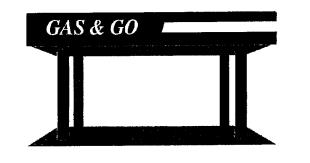
Canopy Sign on Freestanding Canopy
“Changing message center sign” means an electronically or electrically controlled sign where different automatic changing messages are shown on the same lamp bank.
“Civic activity sign” means any sign that advertises a civic event open to the public and sponsored by a political subdivision of the state, educational institution, religious institution, civic or fraternal organization, or similar not-for-profit organization.
Collector Streets. The following streets within the town of Eatonville shall be considered collector streets for the purposes of regulating signs:
1. Carter Street.
2. Lynch Street.
3. Center Street to the west of Eatonville Highway.
4. Rainier Avenue.
5. Orchard Avenue.
6. Pennsylvania Avenue.
7. Weyerhaeuser Road.
8. Bergeren Road.
9. Madison Avenue.
10. Alder Street.
11. Antonie Avenue.
“Construction sign” means any sign used to identify the architects, engineers, contractors or other individuals or firms involved with the construction of a building and announce the character of the building or the purpose for which the building is intended.
Fascia Sign. See “Wall sign (fascia sign).”
“Feather sign” means a sign made of cloth, plastic or similar material affixed to a pole that is located outdoors. Feather signs are “temporary signs,” securely anchored for safety but not permanently anchored to the ground.
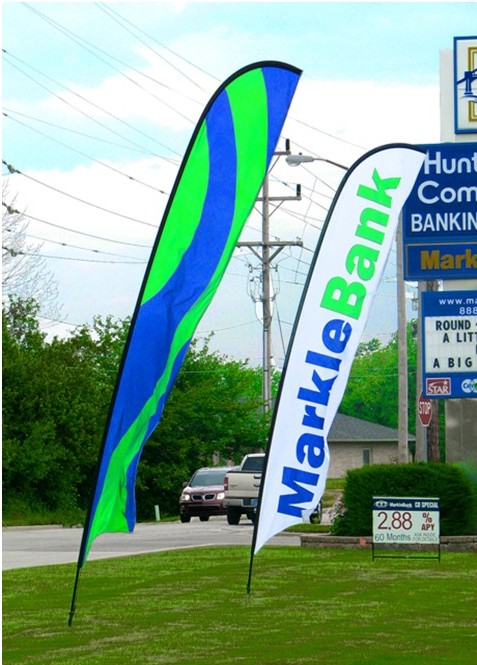
Common Feather Signs
“Flashing sign” means any sign which contains an intermittent or flashing light source or which includes the illusion of intermittent or flashing light by means of animation or an externally mounted intermittent light source. Excluded from the definition are public service signs.
“Freestanding sign” means any sign which is supported by one or more uprights, poles or braces in or upon the ground.
Common Freestanding Sign Types: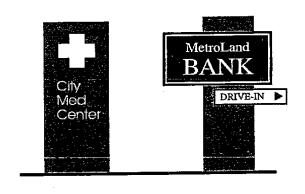
Monument or Blade Pylon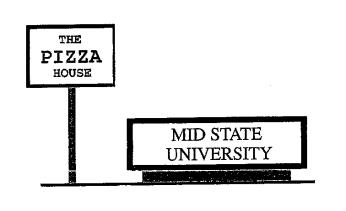
Pole Ground or Low Profile
“Frontage” means the length of the property line(s) of any single premises along either a public way or other properties on which it borders.
“Garage sale signs,” i.e., yard sales, moving sales, patio sales, means temporary signs used to announce a sale of used items.
“Grade” means the elevation or level of the street closest to the sign to which reference is made, as measured at the street’s centerline, or the relative ground level in the immediate vicinity of the sign.
“Grand opening displays” means temporary signs, posters, banners, strings of lights, clusters of flags, balloons and searchlights used to announce the opening of a completely new enterprise or the opening of an enterprise under new management.
Ground Sign. See “Freestanding sign.”
“Height” or “height of sign” means the vertical distance from the grade to the highest point of a sign or any vertical projection thereof, including its supporting columns.
“Incidental signs” are small signs of a noncommercial nature without advertising intended primarily for the convenience of the public and have a maximum area of three square feet. Included are signs designating restrooms, hours of operation, entrances and exits to buildings and parking lots, help wanted, public telephones, no parking, warning, etc. Also included are labels and brand names directly affixed to consumer products such as the brand name of a garbage container or labels indicating “paper recycling.”
“Informational sign” means a sign within a business park or commercial subdivision indicating only the name of a particular use and the direction in which it is located.
“Internal circulation sign” means a sign used to aid customers in circulation within parking lots of commercial properties.
“Landscaping” means any material used as a decorative feature, such as shrubbery or planting materials, planter boxes, concrete bases, brick work, decorative framing or pole covers, used in conjunction with a sign which expresses the theme of the sign and related structure but does not contain advertising copy.
“Mansard roof” means a sloped roof or roof-like facade architecturally able to be treated as a building wall.
“Marquee” is a permanent roofed structure attached and supported by the building.
“Menu board” means a freestanding sign orientated to the drive-through lane for a restaurant that advertises the menu items available from the drive-through window, and which has no more than 20 percent of the total area for such a sign utilized for business identification.
“Multi-tenant” means a building or complex which houses more than one business or nonresidential tenant.
“Multi-tenant ganged sign” means a single freestanding sign with multiple businesses listed on its face(s).
“Legally existing sign” means a sign which has been issued a sign permit or which was erected prior to May 23, 1994 (the date of adoption for Eatonville’s first sign ordinance).
“Nonconforming sign” means a sign which, whether legally erected or not, does not conform to the requirement of this chapter.
“Off-premises sign” means a permanent sign not located on the premises of the use or activity to which the sign pertains.
“Parapet” means an extension of a building facade above the structural roof.
Pole Sign. See “Freestanding sign.”
“Political sign” means a sign advertising a candidate or candidates for public elective office, or a political party, or a sign urging a particular vote on a public issue decided by ballot.
“Portable (mobile) sign” means any sign not permanently attached to the ground or to a building or building surface.
“Projecting sign” means a sign other than a wall sign that is attached to or projects more than 18 inches from a building face or wall or from a structure whose primary purpose is other than the support of a sign.
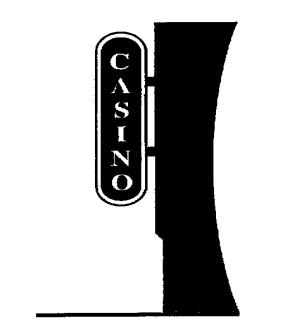
Projecting Sign
“Public agency” means any agency, political subdivision, or unit of local government of this state including, but not limited to, municipal corporations and school districts; any agency of state government; any agency of the United States; and any Indian tribe recognized as such by the federal government.
“Public service sign” means an electronically or electrically controlled public service sign or portion of a larger sign which conveys only information such as activities, events, time, date, temperature, atmospheric condition or news of interest to the general public where different alternating copy changes are shown on the same lamp bank matrix.
“Real estate or property for sale, rental or lease sign” means a temporary sign advertising the sale, lease or rental of the property or premises upon which it is located.
“Roof sign” means any sign erected upon, directly above a roof or on top of or above the parapet of a building.
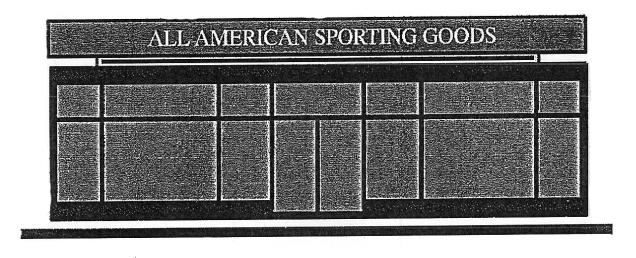
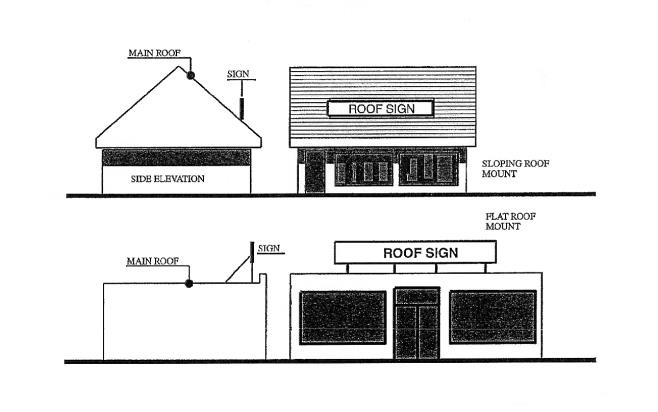
Roof Signs
“Searchlight” means an apparatus containing an electric light and reflector on a swivel for projecting a far-reaching beam in any desired direction.
“Seasonal sales sign” means any sign used to advertise a sale of merchandise or other items during a particular holiday season including seasonal fireworks or Christmas holiday sales.
“Sight triangle” means the area in which no sign shall be situated at a height less than 10 feet or greater than three feet. Please see the diagram below.
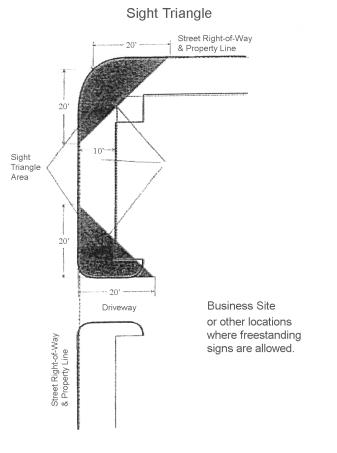
“Sign” means any device visible from a public space that displays either commercial or noncommercial messages by means of graphic presentation of alphabetic or pictorial symbols or representations.
“Sign area” means the area of the smallest geometric figure, or the sum of the combination of regular geometric figures, which comprise the sign face. The following diagrams demonstrate sign area calculations:
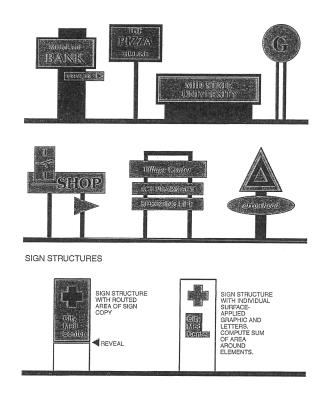
Notes: Sum of shaded areas only represents sign area. Sign constructed with panels or cabinets.
Figure 1003.1(3)
Sign Area – Computation Methodology
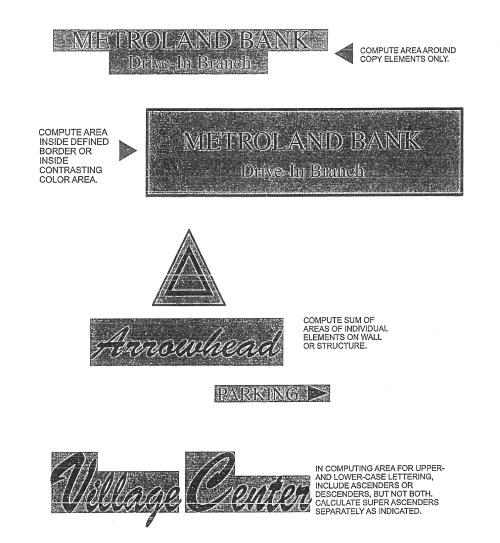
Notes: Sum of shaded areas only represents sign area for code compliance purposes. Examples of signs consisting of individual letters, elements or logos placed on building walls or structures.
Figure 1003.1(4)
Sign Area – Computation Methodology
“Special event signs” means temporary signs used to announce a circus, a carnival, festivals or other similar events.
“Temporary sign” means a sign intended to display either commercial or noncommercial messages of a transitory or temporary nature. Portable signs or any sign not permanently embedded in the ground, or not permanently affixed to a building or sign structure that is permanently embedded in the ground, are considered temporary signs.
“Wall” means any member or group of members which defines the exterior boundaries of a building and which has a slope of 80 degrees or greater with the horizontal plane. The height of a wall shall be measured as the two-dimensional height from the average finish grade of the particular architectural building elevation adjacent to the wall to the finish roof plane.
“Wall sign (fascia sign)” means any sign attached to or painted directly on the wall, or erected against the wall of a building being parallel or approximately parallel to said wall, and does not exceed a distance of 15 inches from said wall.
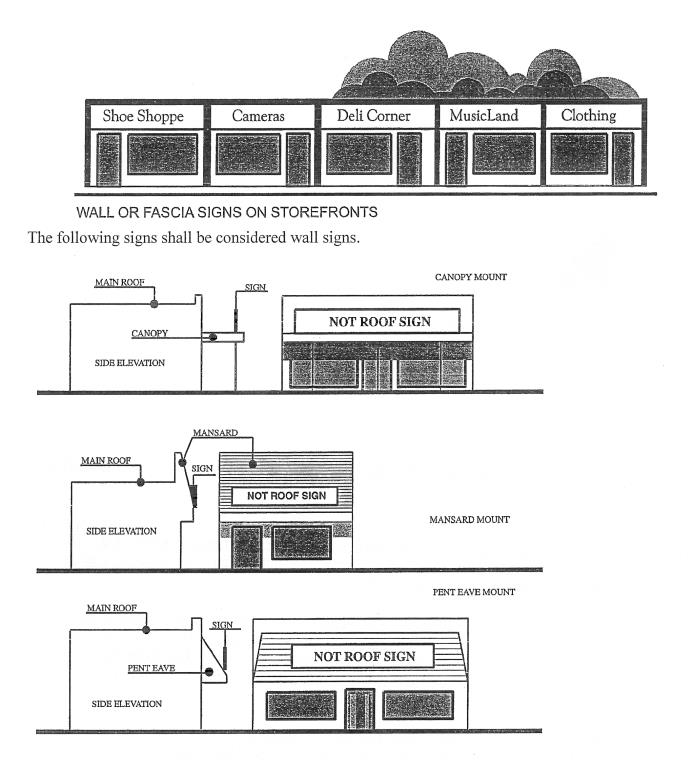
“Way-finding signage” means signs erected by the town on arterial streets directing the public to public, civic, private or nonprofit facilities. Such signs shall not include the names of specific businesses. (Ord. 2014-06 § 4, 2014; Ord. 2007-19 § 2, 2007).
18.06.190 Validity.
If any section, subsection, paragraph, sentence, clause, or phrase of this chapter shall be declared invalid for any reason whatsoever, such decision shall not affect the remaining portions of this chapter which shall continue in full force and effect, and to this end the provisions of this chapter are hereby declared to be severable. (Ord. 2007-19 § 2, 2007).
18.06.200 Savings clause.
This chapter shall not affect violations of any other ordinance, code or regulation existing prior to the effective date of the ordinance codified in this chapter, and any such violation shall be governed and shall continue to be punishable to the full extent of the law under the provisions of those ordinances, codes or regulations in effect at the time the violation was committed. (Ord. 2007-19 § 2, 2007).


